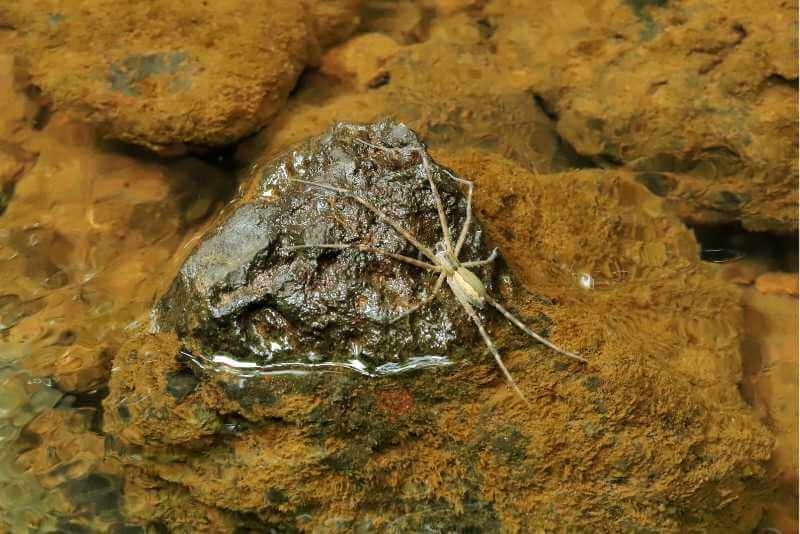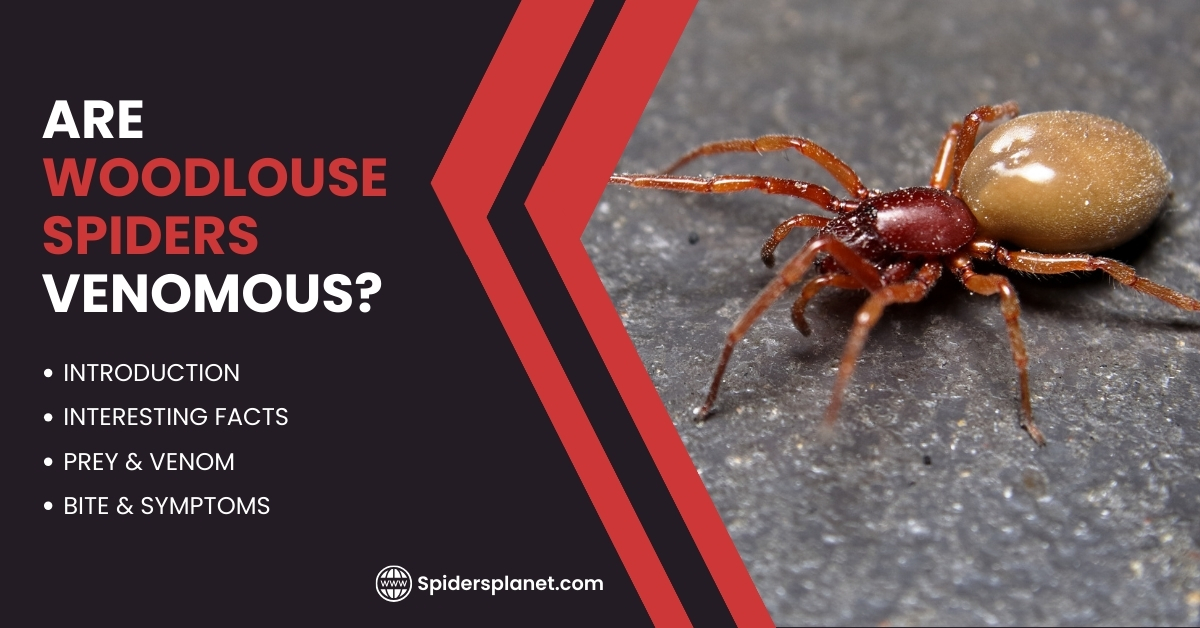Fishing spiders are a truly captivating group of arachnids that are famous for their remarkable hunting techniques and their ability to capture prey both on land and in water. However, there’s been a lot of speculation lately about the color of fishing spiders.
Some say they are light grey while others say they are dark brown. There are even some who believe dark fishing spiders don’t exist, and it’s just another species altogether!
So, in this article, we are going to clear up these rumors once and for all and find out whether, or not dark fishing spiders really exist. Let’s get started…
What Is The Dark Fishing Spider?
Did you know that there are over 100 different species of fishing spiders? That’s right! In fact, the most common type of fishing spider that everyone knows is the light grey one which is actually a member of the “Dolomedes aquaticus”.
But, when it comes to the dark fishing spider, this one is a member of the “Dolomedes tenebrosus” species, and tends to live in woodland areas, residing on trees, or fallen logs.
This differs from the Dolomedes aquatics, which prefers to live near slow-moving water sources such as streams or ponds.

However, one mistake that people often make when looking at a dark fishing spider is confusing it with the wolf spider, mainly because of its color, making it almost identical. But, there are some physical characteristics you can look for to tell whether or not it really is a dark fishing spider.
Physical Description
- Size: Dark fishing spiders have a large size compared to other spiders! The females are larger than males, with a body length between 13 to 26 mm and a leg span of 36 mm. The males are about half the size of females of 11–18 mm, with their legs coming in at 33 mm.
- Coloration: These spiders exhibit a dark brown or grey coloration that serves as excellent camouflage against tree bark, rocks, and other surfaces in their natural habitat, making them difficult for both prey and predators to spot.
- Patterns: Their bodies and legs are adorned with various patterns, including lighter-colored stripes, bands, and markings. These patterns further enhance their ability to blend seamlessly into their surroundings, providing an additional layer of stealth while hunting.
- Eyes: Dark Fishing Spiders possess eight eyes arranged in two horizontal rows, with four eyes in each row. This arrangement provides them with a wide field of vision, allowing them to effectively detect and track potential prey or sense threats in their environment.
- Legs: Their long and robust legs are equipped with hydrophobic hairs, which enable them to walk on water surfaces and even dive underwater for brief periods. This adaptation is crucial for hunting aquatic prey and escaping predators.
- Chelicerae: The spider’s chelicerae, or mouthparts, contain a pair of venomous fangs. These fangs are used to deliver a powerful bite, immobilizing their prey before they consume it. The venom is generally harmless to humans but can cause mild pain or swelling.
Scientific Classification
- Family: The fishing spider, scientifically known as Dolomedes tenebrosus, belongs to the family Pisauridae, commonly known as fishing spiders or nursery spiders. The Pisauridae family is a group of spiders that are commonly found near water and are known for their hunting abilities.
- Genus: Dolomedes is a genus of spiders within the Pisauridae family. They are also known as raft spiders, dock spiders, or wharf spiders. Almost all Dolomedes species are semiaquatic, with the exception of the tree-dwelling D. albinos of the southeastern United States.
- Species: The dark fishing spider, Dolomedes tenebrosus, is a fishing spider found in the United States and Canada. It is one of the largest species of Dolomedes and is known for its impressive hunting skills.
- Order: The fishing spider belongs to the order Araneae, which includes all spiders. Araneae is one of the largest orders of arachnids and is characterized by their two-part body, eight legs, and ability to produce silk.
- Class: Spiders belong to the class Arachnida, which includes other arachnids such as scorpions, ticks, and mites. Arachnids are characterized by their two main body parts, four pairs of legs, and lack of antennae.

Habitat & Distribution
Dark fishing spiders are found in the United States and Canada. They prefer habitats close to water, such as swamps, ponds, and lake margins, but they can also be found in dark and damp situations beneath bridges or culverts, or in rock piles.
United States:
In the United States, dark fishing spiders can be found in various states, including Connecticut, New York, Arkansas, North Dakota, Kansas, Florida, and Texas. They are usually found far away from water, usually in wooded settings.
They hibernate as immature adults (penultimate instar) under stones or loose bark, in tree cavities, and in human-made structures and mature in the spring. Mature individuals may be found from early May through September.
Canada:
In Canada, dark fishing spiders are found in various provinces, including Ontario, Quebec, and Manitoba. They are commonly found near water, such as streams, rivers, and lakes.
They are able to bite humans but will run from people. In most cases, the bite is no more severe than a bee or wasp sting.
Diet And Prey
The Fishing Spider primarily feeds on a variety of invertebrates and small vertebrates found in woodland habitats. Here are some examples of their dietary preferences include:
- Insects: They consume a range of insects such as flies, moths, beetles, grasshoppers, and crickets.
- Arachnids: Dark Fishing Spiders also prey on other arachnids, including smaller spiders and occasionally ticks.
- Caterpillars: They have been known to feed on caterpillars, capturing them on tree trunks or foliage.
- Small Birds: Although rare, they can occasionally prey on small, nestling birds, taking advantage of their vulnerability.
- Frogs: Dark Fishing Spiders are also known to capture and consume small frogs, particularly when hunting near water sources or damp environments.
- Slugs: These spiders are able to climb trees and other vegetation to find their prey. Once they locate a slug, they will use their powerful jaws to crush its shell and extract the soft body inside.
Overall, the fishing spider is a skilled and adaptable predator that is able to feed on a wide range of prey. Their diverse diet allows them to thrive in a variety of habitats, from wetlands to forests.
Reproduction And Life Cycle
Dark fishing spiders reproduce sexually, with the male spider depositing sperm into the female’s reproductive tract during mating.
- Mating Season: Mating season for dark fishing spiders typically occurs in May, June, and July. During this time, males will actively seek out females to mate with.
- Egg Sac: After mating, the female will create an egg sac which she will carry with her until the spiderlings are ready to hatch. The egg sac is typically a round, papery structure that is attached to the underside of the female’s abdomen.
- Spiderlings: Once the spiderlings are ready to hatch, they will emerge from the egg sac and climb onto their mother’s back. The female will then create a nursery web to house the spiderlings until they are large enough to hunt on their own.
It’s worth noting that sexual cannibalism can occur during mating, with the female sometimes consuming the male after copulation. However, this behavior is not always observed in dark fishing spiders.
Overall, the life cycle of dark fishing spiders is relatively short, with the spiderlings reaching maturity in just a few months.
Behavior And Adaptations
Venom:
Dark fishing spiders are venomous, but their venom is not considered dangerous to humans. Their bites are often compared to bee or wasp stings in terms of severity.
However, individuals who are allergic to spider venom may experience more severe reactions. The spiders use their venom to subdue prey, which they catch using their powerful front legs.
Vision:
Dark fishing spiders have excellent vision, which they use to hunt for prey. They have eight eyes arranged in two rows, with the front row consisting of four small eyes and the back row consisting of four larger eyes.
The larger eyes are particularly important for detecting movement, while the smaller eyes are more sensitive to light. This combination of eyes allows the spiders to detect prey both in daylight and in low-light conditions.
Vibrations:
Dark fishing spiders are able to detect vibrations in the water, which they use to locate potential prey. They have specialized hairs on their legs that are sensitive to vibrations, allowing them to detect the movements of small fish and other aquatic creatures.
Once they detect prey, the spiders can walk on the surface of the water to capture it.
Overall, dark fishing spiders are well-adapted to their environment, with a combination of excellent vision and sensitivity to vibrations allowing them to hunt successfully both on land and in water.
While their venom is not considered dangerous to humans, it is still important to avoid handling these spiders to prevent bites.
Conclusion
So, now you know everything there is to know about the dark fishing spider! Hopefully, this article cleared up any questions you may have about these species!
However, if you want to know more about fishing spiders we have a whole category about these species on our home page.



